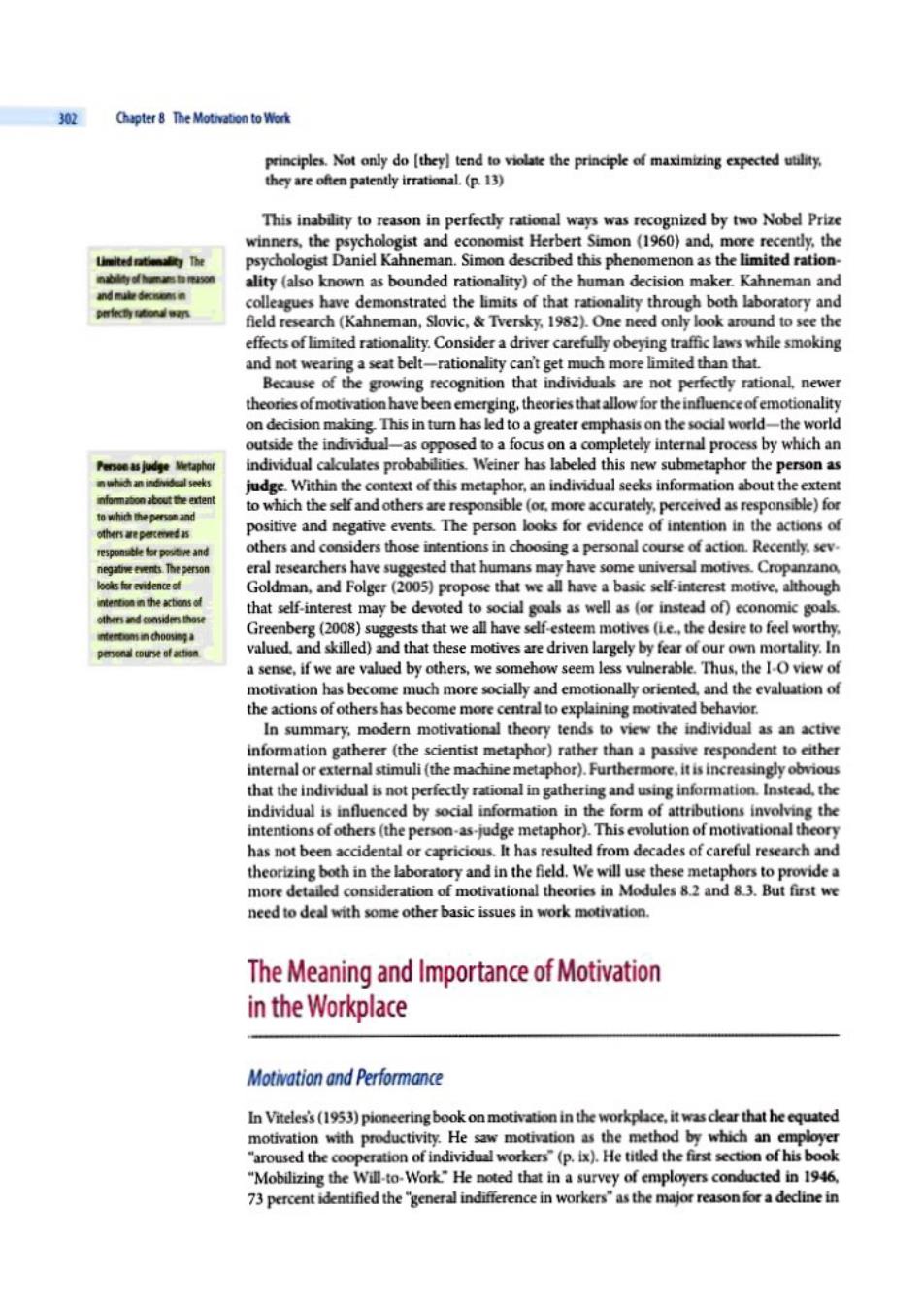正在加载图片...

302 Chapter 8 The Motiation to Work principles.Not only do [theyl tend to violate the principle of maximizing expected utility. they are often patently irrational.(p.13) This inability to reason in perfectly rational ways was recognized by two Nobel Prize winners,the psychologist and economist Herbert Simon (1960)and,more recently,the psychologist Daniel Kahneman.Simon described this phenomenon as the limited ration. ality (also known as bounded rationality)of the human decision maker.Kahneman and and mahe decionsn colleagues have demonstrated the limits of that rationality through both laboratory and field research (Kahneman,Slovic,Tversky.1982).One need only look around to see the effects of limited rationality.Consider a driver carefully obeying traffic laws while smoking and not wearing a seat belt-rationality can't get much more limited than that. Because of the growing recognition that individuals are not perfectly rational,newer theories ofmotivation have been emerging,theories that allow for the influence ofemotionality on decision making This in turn has led to a greater emphasis on the social world-the world outside the individual-as opposed to a focus on a completely internal process by which an Persoe as judge Metaphor individual calculates probabilities.Weiner has labeled this new submetaphor the person as 菌whidan indidal seek灯 judge.Within the context of this metaphor,an individual seeks information about the extent informabon about the ertent to whid the persan and to which the self and others are responsible (or.more accurately,perceived as responsible)for he作etd5 positive and negative events.The person looks for evidence of intention in the actions of respontlefor posteand others and considers those intentions in choosing a personal course of action.Recently,sev. neg呢events.The person eral researchers have suggested that humans may have some universal motives.Cropanzano loolsfor evidence味 Goldman,and Folger (2005)propose that we all have a basic self-interest motive,although that self-interest may be devoted to social goals as well as (or instead of)economic goals. others and considers those Greenberg (2008)suggests that we all have self-esteem motives (ie.,the desire to feel worthy. valued,and skilled)and that these motives are driven largely by fear of our own mortality.In a sense,if we are valued by others,we somehow seem less vulnerable.Thus,the I-O view of motivation has become much more socially and emotionally oriented,and the evaluation of the actions of others has become more central to explaining motivated behavior. In summary,modern motivational theory tends to view the individual as an active information gatherer(the scientist metaphor)rather than a passive respondent to either internal or external stimuli (the machine metaphor).Furthermore.it is increasingly obvious that the individual is not perfectly rational in gathering and using information.Instead,the individual is influenced by social information in the form of attributions involving the intentions of others (the person-as-judge metaphor).This evolution of motivational theory has not been accidental or capricious.It has resulted from decades of careful research and theorizing both in the laboratory and in the field.We will use these metaphors to provide a more detailed consideration of motivational theories in Modules 8.2 and 8.3.But first we need to deal with some other basic issues in work motivation. The Meaning and Importance of Motivation in the Workplace Motivation and Performance In Viteles's(1953)pioneering book on motivation in the workplace,it was clear that he equated motivation with productivity.He saw motivation as the method by which an employer "aroused the cooperation of individual workers"(p.ix).He titled the first section of his book "Mobilizing the Will-to-Work"He noted that in a survey of employers conducted in 1946. 73 percent identified the 'general indifference in workers"as the major reason for a decine in